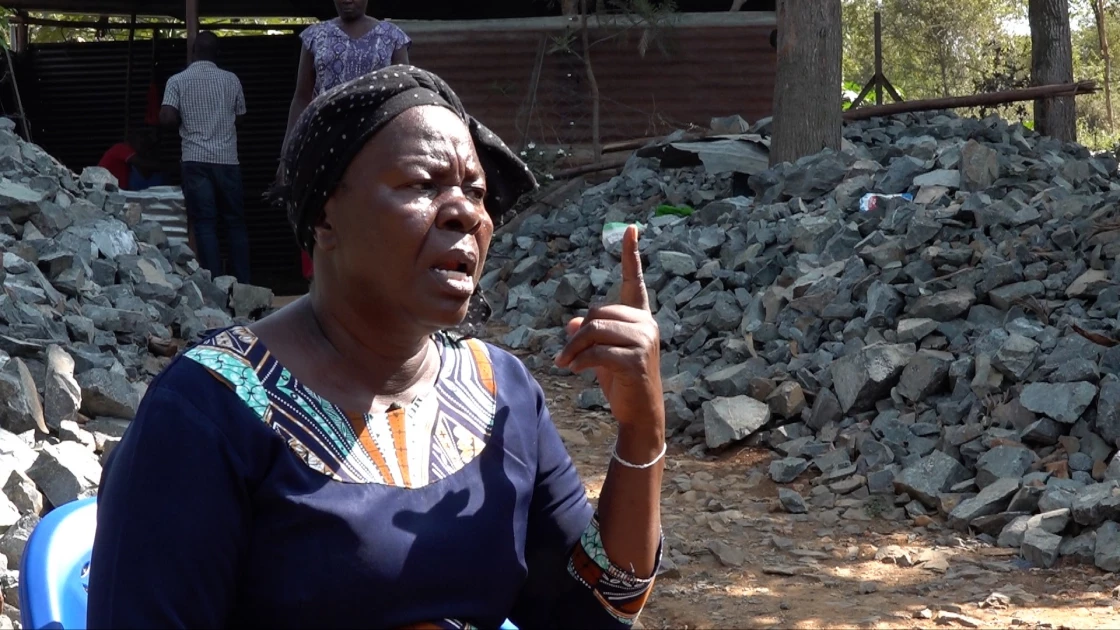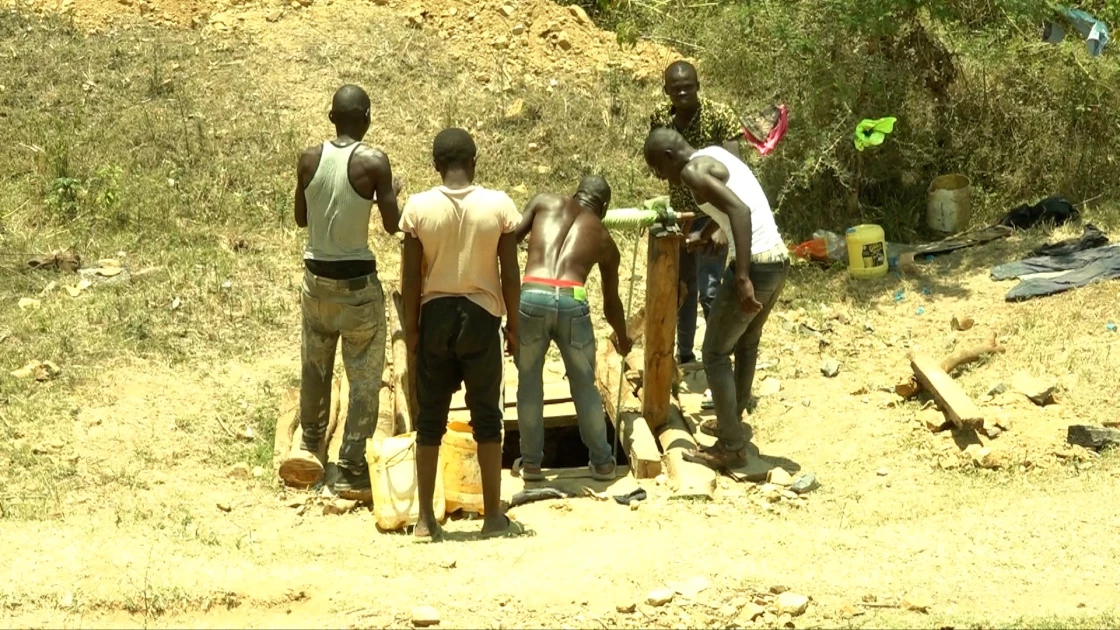Hidden Gems: Women defying gender norms to venture into artisanal mining

A woman breaks rocks with gold deposits at Abimbo, Siaya. Photo I Laura Otieno

Audio By Vocalize
Homesteads seem concentrated in one place, and large swathes of bare land occasionally appear in areas where there is no human settlement.
Mobile phone reception is shaky, but after manoeuvring, we find a slightly elevated hill with just enough reception to trace the home of Alice Owiti.
Owiti is popularly known as Nyaimbo, and after a few wrong turns in the dusty village, we stumble upon a group of motorbike riders who direct us to Nyaimbo’s homestead. Nyaimbo is an artisanal gold miner.
According to Kenya’s Ministry of Mining and Blue Economy, mining contributes less than 1% to the country’s economy.
The Cabinet Secretary for Mining and Blue Economy announced a robust plan to upscale the contribution to 10% of the GDP by 2030, which includes the empowerment of artisanal and small-scale miners.
In a report published by the Office of the Auditor General in 2022, artisanal gold mining employs 250,000 people, with 40% of the workforce in the mines being women.
Nyaimbo leads us through a manoeuvring path laced with rocks and occasional shrubs. We pass groups of people, some digging up what looks like ground wells, a group of women breaking pieces of stones with a hammer, and another group sifting a fine heap of white dust, under the scorching sun.
They all jolt into action once Nyaimbo passes, some greet her as we make our way into her compound. We sit under a papaya tree, shielding from the scorching sun.
Nyaimbo is a landowner. In artisanal gold mining, land owners earn the highest from the prospects mined from their pieces.
On her vast 5-acre piece, Nyaimbo has six shafts where she is actively involved in artisanal gold mining. Her face beams with pride as she points to her stone 3-bedroom house which she recently put up.
“This cost me millions of shillings, it is not yet complete but it is one of the many projects I have to show from the prospects of gold mining,” she says beaming with pride.

When her husband died in 1996, Nyaimbo resorted to menial jobs to cater for her infant daughter. She would wander in the mines, sourcing leftover stones to crush and sell for negligible deposits of gold.
“The most I could make in a day was Ksh.800, but over the years, things got so bad, I could barely get Ksh.100. The men in the mines became hostile and decided to only expose the mined stones at night, by then most of us (women) would have long left the mines, we cannot stay until evening,” she recalls.
Our interview is interrupted by a man who brings a sheet of paper, after a brief discussion lasting about two minutes, Nyaimbo asks the man to prepare a duplicate sheet and leave her with one.
“I always keep track of the number of sacks after every three hours, you have to be very keen otherwise they will dupe you,” she tells us.
Mining, the mainstay
It was a decade of toil and sweat to put food on the table. In 2013, after a discussion with her brother-in-law, Nyaimbo ventured into artisanal gold mining.
She took out a loan of Ksh.100,000 from a table banking group and hired a compressor to drill at one corner of her late husband’s land.
Abimbo is largely an artisanal gold mining haven. The mainstay for residents here is gold mining and selling.
The South Sakwa Gold Miners and Credit Cooperative Society which operates in the area, has a membership of 1500 members.
Cooperative chairperson Tom Ogilo however says the number could be higher, as some miners are yet to register with the cooperatives.
In Nyanza and Western Kenya, the Ministry of Mining has mapped out gold deposits in six counties including Kisumu, Kakamega, Siaya, Busia, Bungoma and Migori.
Alice Owiti has a mining shaft just five metres from the back door of her house. In her 5-acre piece of land, she has a total of six shafts, with five being active. One of the shafts has been “closed” for some time.
She is hoping to get an investor, who can bring in the necessary machinery to drill through the rock.
“Gold never depletes, you only need to get more sophisticated equipment to drill and you will find more. The shaft is viable, I am looking for someone to help out with the machinery”.
According to the World Gold Council, gold mining has flatlined over the last decade, with an average production of 3,000 tonnes per year.
The council further indicated a decrease in the amount of accessible gold in mines, which currently stands at 54,000 tonnes.
According to information published on its website, it will require sophisticated equipment and the application of Artificial intelligence to mine gold in the next 50 years, a capital-intensive venture which might edge out miners, even those operating in large-scale mines.
According to the South Sakwa Gold Miners Credit and Cooperative Society chair Ogilo, only 12% of women in the area own mines.
Ogilo says, the capital-intensive venture makes women shun the trade, whose annual turnover can be into millions of shillings should one have the right equipment.
“A compressor and a water drill are essential. Once you dig further down, the rock sediments are hard and cannot be broken down by hammers, you will need explosives and other equipment, these cost over Ksh.1.5 million, so more often than not, women strain to raise this capital,” he says.
In a report published by the Kenya Land Alliance in 2021, women make up 45% of the workforce in artisanal gold mines.
The data shows that 80,000 of the women who were interviewed reported making just enough money to feed their families.
Men on the other hand, who are involved in digging up the ore from the shafts make a more significant amount, as they negotiate their pay depending on the sacks of ore extracted over time.
“The men get paid depending on the weight of the rocks, while the women will get money depending on how much gold they can wash off. With the small amount of mercury, it could take you weeks to get a gram. Men can make up to Ksh.3,000 a day depending on how much rock they dig up,” Mr Ogilo explains.

Any gold measuring less than one gram is measured by a small spatula and is categorised as a “point”. One “point” costs Ksh.50. One would need about 500 points to get one gram of gold which fetches up to Ksh.8,000 in the market.
In a regional tripartite meeting held in Dakar, Senegal convened by the International Labour Organization in July 2023, some of the fronted recommendations included the capacity building of women in artisanal mining, and ensuring the implementation of regional instruments and country-specific laws that will weed out barriers for women in making substantial returns from the sector.
Nellie Mutumeri, an Associate Professor at the University of Witwatersrand in South Africa pointed out the continuous overlooking of women in the mining sector, calling for the implementation of the Maputo protocol which guarantees extensive rights for women to participate in the political process, as well as protection of women and girls against harmful practices.
“I would want to see deliberate gender inclusive effort in formulating the AfCTA (Africa Continental Free Trade Area) protocols because mining has approximately five million women across Africa and the protocols present an opportunity to bridge the gender gap and offer services to women in mining across the spectrum including exploration, contract mining and laboratory services.”
Women left to do menial jobs
About six metres from a mining shaft, 50-year-old Florence Achieng’ is chipping pieces of rock. Beside her, lays a bucket full of pieces of larger rocks.
Her hands work with the skill of time, she engages in a chitty chat with three other women who are spread around a tiny shade.
A small cloud of dust rises with each fall of a hammer, and despite the loud noises of rocks breaking under the weight of metal, the women seem rather comfortable and even laugh as they carry on with work.
“Once you get used to this job, your nose becomes familiar with dust and your ears adjust to the noise,” says Adhiambo.
“Look at my skin, this job has made me young”, she adds amidst a hearty laugh."
Beneath the bubbly talk, Adhiambo says she wishes she had her own shaft. She has been working at Nyaimbo’s shafts for three years now.
Her husband has refused to grant the required written permission as the land owner, to facilitate the application of an artisanal mining permit for their three-acre piece located one kilometre from one of the sites where she works.
“We have seven children, and looking at how shafts are left open, he said we would rather save the land so that our sons can have a place to set up their houses according to the Luo culture,” she adds.
Abimbo is predominantly occupied by the Luo community. According to the Luo culture, the eldest son of a family is required to build a house known as “Simba” on the right side of their parent’s house.
The second eldest son will build on the left side. Girls, however, are expected to marry.
Should a girl choose not to marry, she will stay in her father’s house, as the tradition does not grant any rights for a woman to build a house in her father’s compound.
If married, however, the married woman is allowed to build a house and develop where her husband has been allocated land.
“You know they call us guests, so culturally I have no right over this land. But if it were up to me, I believe we can make good money and buy land elsewhere for our sons to build their "Simba”.
While Abimbo breaks pieces of rock to source gold, her husband cultivates on two of the three-acre pieces.
“We do not get much because as you can see the land here is bare. His decision is final so we cannot source for gold on our land but I hope to one day become a landowner so that I make enough money to support my children”.
Land ownership and women

While small-scale and large-scale permits are issued through the Kenya Mineral Rights Board, artisanal mining permits are issued through the county artisanal mining committees.
To acquire an artisanal mining permit, one would be required to submit proof of being a Kenyan citizen and affiliation to an artisanal mining cooperative or association, and where the permit is sought by a person other than the owner of the land, the holder shall compensate the proven land owner.
Should Nyaimbo apply for an artisanal mining permit in her name, she will have to compensate her husband for the prospects earned from mining, at a ratio to be negotiated between the two parties.
Article 21 of the Protocol to the African Charter on Human and People’s Rights on the Rights of Women in Africa, popularly known as the Maputo Protocol, states that women and men have the right to inherit, in equitable shares their parents’ property. Kenya acceded to the protocol in October 2010, vowing to protect the rights of women and girls.
Similarly in Kenya, while the Law of Succession Act 2012 does not specify regulations regarding gender, it states that all children have an equal entitlement to the inheritance of their deceased parent’s estate.
Nyaimbo got her pieces of land from her husband, however, the titles are still in her late husband’s name.
“I have very good in-laws, I have never seen the need to change the names on the title. But I intend to transfer the title to my daughter. I want her to benefit from this when I am gone and it is the only way I can protect her just in case things go haywire in future”.
Bridging the gender gap
A performance audit report by the Office of the Auditor General released in 2022 showed that about 250,000 people are employed directly in artisanal gold mining, with the artisanal mining sector supporting an average of 800,000 people.
In October 2023, the government decriminalised artisanal mining, in a bid to empower more communities to undertake the venture for economic gain.
Following this, the State Department of Mining embarked on a registration drive, directing all artisanal miners to register through cooperatives. Mining Permanent Secretary Elijah Mwangi indicates that about 156 cooperatives have been registered.
“We are issuing targeted support with things like capacity building, equipment, funding linkages and markets through artisanal miners, but we can only do this through the cooperatives so we urge more of these miners to register through the portal,” said the PS.
While on a working tour in the Western and Nyanza regions in August, mining Cabinet Secretary Hassan Joho indicated the plans to ensure that artisanal miners got the necessary support to weed out exploitative entities.
“It is unfair to see that the local people make peanuts from the same mineral that finances a lavish lifestyle for some middlemen. I am already rationalising that anybody who is honestly engaged in artisanal mining will have something to show for it at the end of the day. I will ensure that everybody regardless of age, gender or social status has something to smile about as long as they are mining following the right channels,” said Mr Joho.
Back in Abimbo, a three-bedroom stone house that majestically stands on a piece of land is one of the most notable achievements Nyaimbo says have come from her mining venture. Her face beams as she explains how she has shielded herself from the shadowy intermediates that often fleece women.
“I have to establish the rules of engagement early. I used to be naïve but nowadays, we split according to percentage. As the owner of the land, we agree with the person who has leased the equipment to me, and the people mining, that is why these records are precious to me,” she says as she clutches three sheets of paper, indicating the number of bags that have so far been extracted over the last two weeks.
Mr Ogilo also says the association is keen on weeding out gender discrimination and affording equal opportunities to those in the sector.
“I take it as a personal responsibility to train women because as we speak, they are the ones that are exploited. The men are unfair because they know women do not go down the shafts, they would want to split profits based on the weight of rocks extracted, but I always encourage women and some men, to work with the percentage formula to split profits, it is my little way of ensuring gender equality in Abimbo,” says Mr Ogilo.
As we drive from Nyaimbo’s compound, the sun is already sinking, casting a golden shadow on the skyline. She waves to us as we make our way down the dusty path to connect to the main road. Looking back at her, she is standing on a pile of sand, towering above the shafts. Her demeanour is an inspiration to women like Florence, and the hundreds of women at Abimbo mines, that women too can break even in the artisanal mining sector.


Leave a Comment